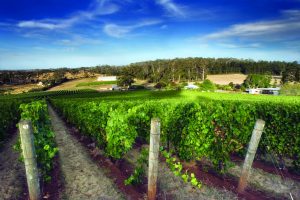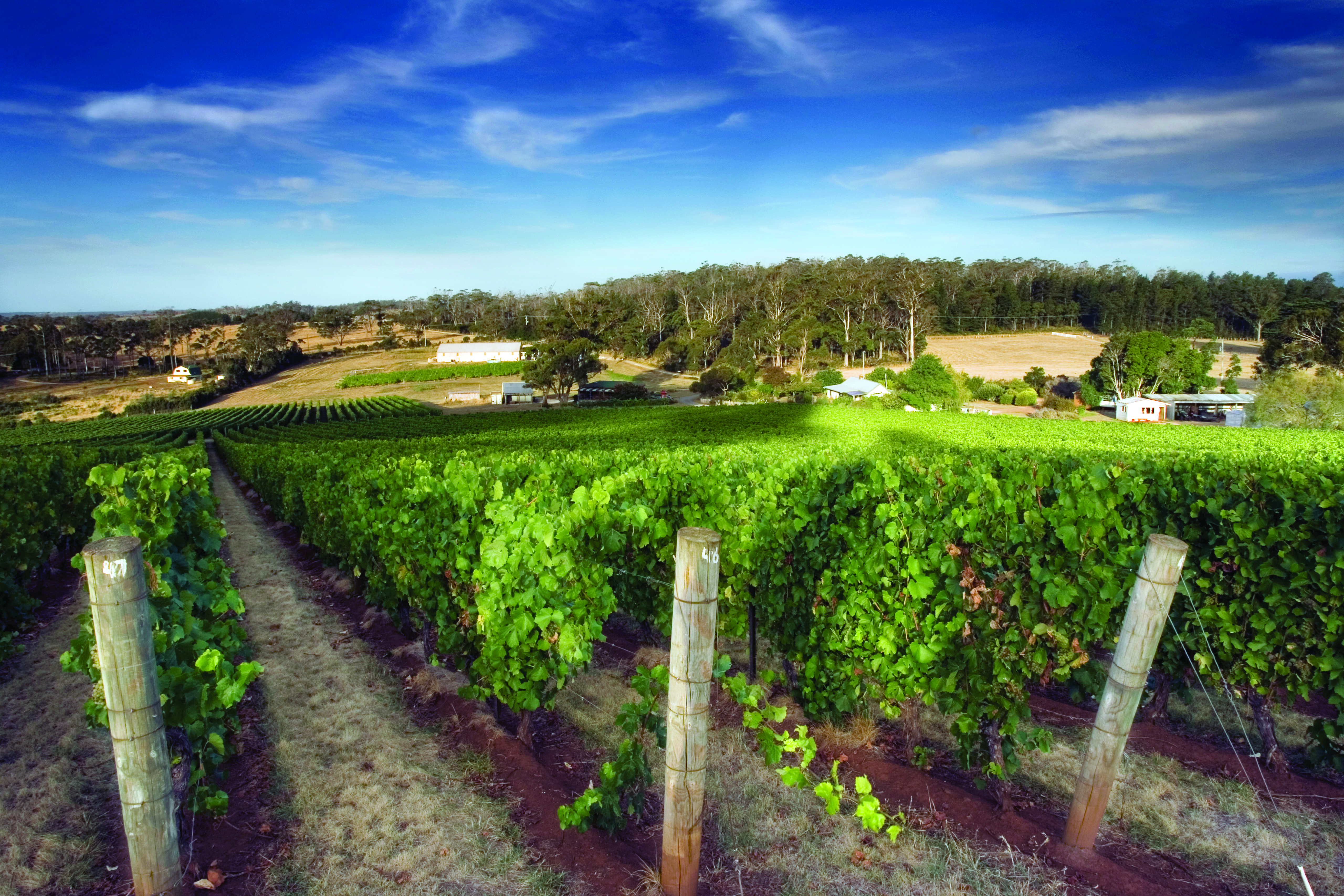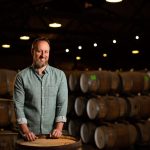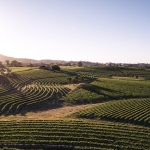While firmly rooted in South Australia’s Barossa Valley, the Hill Smith family and its stable of wine companies has grown considerable branches in Tasmania over the last 20 years: Mark Smith tells the story so far.

Dalrymple Vineyard in Tasmania’s Pipers River region, which was acquired by the Hill Smith family in 2007.
For a bloke who relinquished his official marketing roles with Yalumba Wines 20 years ago, it seems company chairman and industry visionary Robert Hill Smith isn’t about to forget the four Ps of marketing any time soon. Indeed, in true entrepreneurial spirit, Hill Smith has spent the last two decades building foundations for a new, 21st century marketing mix. Foundations for product, place, price and promotion that lie 1200km beyond his beloved Barossa Valley — on the other side of Bass Strait. Hill Smith’s odyssey in Tasmania began in 1997 when he orchestrated the purchase of the former Heemskerk Jansz brand from Pipers Brook Vineyard. At the time, the state’s entire industry comprised 369 hectares. Today, it’s a little more than 2000 hectares.
The company’s somewhat tenuous roots in the district’s rich red krasnozems found a foothold in September 2001 when Hill Smith bought 23 hectares of Chardonnay, Pinot Noir and Pinot Meunier and became Pipers Brook’s vineyard neighbour. The 20 blocks purchased included those that contributed to the embryonic sparkling wine program Heemskerk founder Graham Wiltshire began in 1985. That move into Tasmanian vineyard ownership provided the first signs of Hill Smith’s commitment to two significant P-words: Pipers and passion. The third — P for patience — became evident six years later with the purchase of Pipers River producer Dalrymple Vineyards. The small, family-owned operation was ripe for the picking. Its owners were seeking retirement, and the property was barely two kilometres from Jansz Tasmania.
Launceston oncologist Dr Bertel Sundstrup, his wife Anne, and his sister-in-law Jill Mitchell had established Dalrymple in 1987 with the encouragement of Taltarni Vineyard’s Dominique Portet. The Victorian company had been keen to negotiate the purchase of significant quantities of Chardonnay and Pinot Noir to supplement planned harvests from its fledgling Clover Hill Vineyard, planted nearby at Lebrina in 1986. South Australian blow-in Shane Holloway (now co-owner of Delamere Vineyards) and then celebrated Jansz sparkling winemaker Natalie Fryar took up the Dalrymple winemaking reins after Sundstrup, before former Te Kairanga winemaker Peter Caldwell arrived to process the 2011 vintage.
Born in New South Wales and raised in Tasmania, Caldwell had just spent 10 years in New Zealand helping to re-invent the renowned Martinborough producer. Te Kairanga was first planted in 1978, but its vines had failed. A subsequent mortgagee sale and new ownership then brought welcome investment capital to the struggling project. Caldwell’s decade at Te Kairanga — shared with his French wife and fellow winemaker Mayi — included the establishment of more than 300 hectares of vines on three different sites. Construction and operation of a large modern winery added black ink to the company’s balance sheets. Caldwell’s return to his home state brought back fond memories. As a bright-eyed kid, fresh out of school, Caldwell had taken on work in Pipers River at the beginning of the 1990s. His boss at Heemskerk discovered Caldwell was smart and quick to learn as well. “Peter showed more promise and had a greater feel for growing vines than any of the fifty or so novices I employed during all my time at Heemskerk,” Graham Wiltshire recounted in the years before his death in 2014. “In fact, I like to think that I was responsible for launching his career. I told him he asked too many questions. Eventually, I gave him the sack and said he needed to head to Roseworthy to get a degree.”
Caldwell smiles broadly when he hears that tale of woe. “Working with Graham was great, because when I began studying viticulture at Roseworthy College, I found it was nothing like being in Tasmania,” Caldwell recalls. “There, it was all hot climate, grow-asmuch-as-you-can stuff. It was a different world. Here, everyone in the industry acknowledged that quality wine is made in the vineyard — and that’s still where all our best efforts are directed.” Wiltshire would not be the least bit surprised to find Caldwell has excelled in his new role of Dalrymple vigneron. In addition to expanding vineyard plantings by 50 percent to see them reach 18 hectares, Caldwell has rejuvenated Dalrymple’s winemaking operations. And along with a new warehouse and barrel room, an insectarium has appeared on the property. Caldwell’s primary focus in the Pipers River region is the production of modern, stylish table wines. Recent additions to the Dalrymple portfolio include a range of discretely different, single site Pinot Noirs from the Coal River Valley, East Coast (Swansea) and Derwent Valley (Ouse).
Jansz Tasmania, meanwhile, retains its focus as a producer of Tasmanian sparkling wine, par excellence. Now into its fourth decade of production on the island, bottlefermented sparkling wine first entered Hill Smith’s stream of consciousness in 1978 with a visit to Champagne. Indeed, he’s quick to note Champagne Pol Roger and Yalumba Wines both celebrate 170th anniversaries in 2019.
Less widely known is that Hill Smith figured among the handful of Australian wine industry luminaries that welcomed a 1980 delegation of VIPs from Möet & Chandon.“We travelled all over South Australia and Victoria before ending up in Tasmania,” Hill Smith recalls. “We kept in touch after their return home. Eventually, the report of their trip just happened to fall into my hands. The interesting part was that it unashamedly nominated Pipers River as the place the company would most want to come to in Australia. Even then, its fruit quality was markedly better than anything being grown at their Californian vineyard.”
Somewhat surprisingly, it would be a Californian connection that delivered Hill Smith the fourth P in his cool climate wine strategy — Penna, the southern Tasmanian home of Frogmore Creek Vineyard, since renamed Jansz Parish Vineyard.
Frogmore Creek founder Tony Scherer had been a vegetable grower in California’s Santa Cruz Valley in the late 1960s. By the mid-1970s, he had been bitten by the sustainable agriculture bug. By the early 1990s, Scherer had quit farming in the US and had made his way to Margaret River, practising his organics preach with Cape Mentelle and Cullen Wines.
The Californian was soon drawn to the prospect of owning a fully certified organic vineyard. The stark reality was that Scherer had arrived too late in WA’s south-west. Land prices were already out of reach, ensuring lesser-known regions of the country like Tasmania were to become the focus of his attention.
Like Hill Smith, Scherer and his US business partner Jack Kidwiler entered the Tasmanian wine industry in 1997. They purchased almost 300ha of land at Penna on the edge of the Coal River Valley. Barely 10 kilometres from Richmond and 15 kilometres from Hobart Airport, its dry, windswept hilltops were little known by people living in nearby Hobart. The district had a postcode, but no post office. One had opened there in 1914 and had closed for good in 1955.
Scherer and his rigorous organic vineyard regimes struck pay-dirt almost immediately. The property’s first Pinot Noir — a 2002 Reserve label — won two trophies at the 2004 Tasmanian Wine Show and was named Best Wine. Over the next decade, Chardonnay and Riesling wines were to enjoy similar success and media acclaim as the vineyard expanded to 26 hectares.
In 2008, Frogmore Creek welcomed a success story of a different kind —an up-and-coming young viticulturist named Jennifer Doyle. Like Caldwell, Doyle was born in rural New South Wales and had been brought up on a working farm before taking holiday jobs on vineyards and making career choices in viticulture. And like Scherer, she too had been drawn to Western Australia — to Pemberton and Margaret River — before heading to cooler climes in Orange and then southern Tasmania.
Scherer’s passion for vineyard sustainability was infectious, and Doyle was a willing participant in bringing it to fruition on the challenging Frogmore Creek site.
“Viticulture really is a dynamic pursuit, one that’s constantly changing with the ebb and flow of environmental influences,” Doyle explains.
She’s the first to admit this part of Tasmania holds its cards close to its chest. Far from being cold, wet and miserable for much of the year, the Coal River Valley figures among Australia’s driest wine regions. Long-term average annual rainfall at nearby Hobart Airport is officially 497mm, while Frogmore’s own weather station receives barely 450mm. That’s significantly lower than South Australia’s Lenswood (1008mm) and Coldstream (729mm) in southern Victoria.
The vineyard’s close proximity to Pitt Water and Orielton Lagoon buffers the high summer temperatures experienced around Campania, further north in the Coal River Valley. Mean January temperature maxima reach 22.5ºC at Penna.
Just three years into her appointment as vineyard manager, Doyle was named a finalist in the Tasmanian wine industry’s 2011 Don Martin Sustainable Viticulture Award. The following year, she became the award’s worthy winner, using its $10,000 bursary to fund extended overseas travel to New Zealand, France and the US.
Success breeds success. In late 2012, Doyle became a part of Hill Smith Family Vineyards with the purchase of Frogmore Creek and its subsequent re-branding as Jansz Parish Vineyard. An adjacent land title was also snapped up, and with Doyle’s steady guidance it has become Mount Lord Vineyard.
Along with responsibility for 62ha of vines at Penna, Doyle now bears the title of Jansz vigneron. It fits perfectly. Last November, she was named Viticulturist of the Year at the 2017 Australian Women in Wine awards in London. In May this year, Jansz Parish Vineyard accepted the mantle of 2018 Gravitas Energy Tasmanian Vineyard of the Year. That’s not all that happened in Hill Smith’s 20th anniversary year in Tasmania. Having successfully re-jigged vineyard management at Dalrymple and Jansz’s sparkling wine blocks at Pipers River, Peter Caldwell cast his gaze across northern Tasmania for additional vineyard land. He found 42 hectares of spectacular grazing country at White Hills outside Launceston, part of which borders the 21st century Heemskerk Vineyard now owned by Treasury Wine Estates. Oddly enough, among the first Europeans to explore the region in 1806 was none other than Ensign Hugh Piper, the British naval officer who had traversed north-east Tasmania earlier that year and eventually gave his name to the district that is Jansz Tasmania’s home base. Caldwell expects the new Glenview Vineyard will have completed installation of a 60ML dam and 35 hectares of vines by Christmas 2018.
The site should fit neatly into the comfort zone of the former Te Kairanga winemaker. Its neighbouring White Hills vineyard was established in 2004-05 by the Gunns-owned company of Tamar Ridge Wines. Studies by consultant viticulturist Dr Richard Smart indicated the district’s climate data bore striking resemblance to that of New Zealand’s Martinborough region, making it eminently suited to Pinot Noir.
Doyle, meanwhile, ended 2017 with a flurry of activity. Like her northern counterpart, she too found herself knee-deep in vineyard development on a greenfield site. Woodside can be found at Forcett, not far from the busy highway that leads to Port Arthur and the Tasman Peninsula. Once part of a grazing property with multiple land titles, the 40-hectare site is now fully planted, and is less than a 15-kilometre drive from Penna.
Planting material required by each of the six sites Hill Smith Family Vineyards holds in Tasmania is sourced directly from the company’s Yalumba Nursery in the Barossa Valley. That’s a good deal easier than it was a few years ago when bio-security measures in Tasmania meant rooted vines could only come via a field nursery in the Derwent Valley operated by the Clark family.
Today, everything arrives in the state on rootstocks that have undergone rigorous fungicide and heat treatments. Yalumba Nursery manager and viticulturist Nick Dry admits he’s had busy times but has found his pivotal role personally and professionally rewarding.
“It’s been one my most significant achievements,” he says. “It’s brought together two key threads of my working life – specialised rootstock research and the day-to-day pleasures of being a vineyard nurseryman.”
Dry might well pause for breath at the moment, for who knows what Tasmanian wine card Robert Hill Smith will play next? Would you bet on something starting with P?

Robert Hill Smith, whose family’s foray into Tasmania began in 1997 when Hill Smith purchased the former Heemskerk Jansz brand from Pipers Brook Vineyard.
This article was originally published in the October 2018 issue of Grapegrower & Winemaker magazine.
For articles like this and more, subscribe to the Grapegrower & Winemaker now!
















